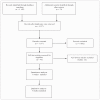Reconnection surgery in adult post-operative short bowel syndrome < 100 cm: is colonic continuity sufficient to achieve enteral autonomy without autologous gastrointestinal reconstruction? Report from a single center and systematic review of literature
- PMID: 29182898
- PMCID: PMC5725160
- DOI: 10.11138/gchir/2017.38.4.163
Reconnection surgery in adult post-operative short bowel syndrome < 100 cm: is colonic continuity sufficient to achieve enteral autonomy without autologous gastrointestinal reconstruction? Report from a single center and systematic review of literature
Abstract
A systematic bibliographic research concerning patients operated on for SBS was performed: inclusion criteria were adult age, reconnection surgery and SBS < 100 cm. Autologous gastrointestinal reconstruction represented an exclusion criteria. The outcomes of interest were the rate of total parenteral nutrition (TPN) independence and the length of follow-up (minimum 1 year) after surgery. We reviewed our experience from 2003 to 2013 with minimum 1-year follow-up, dealing with reconnection surgery in 13 adults affected by < 100 cm SBS after massive small bowel resection: autologous gastrointestinal reconstruction was not feasible. Three (out of 5168 screened papers) non randomized controlled trials with 116 adult patients were analysed showing weaning from TPN (40%, 50% and 90% respectively) after reconnection surgery without autologous gastrointestinal reconstruction. Among our 13 adults, mean age was 54.1 years (53.8 % ASA III): 69.2 % had a high stomal output (> 500 cc/day) and TPN dependence was 100%. We performed a jejuno-colonic anastomosis (SBS type II) in 53.8%, in 46.1% of cases without ileo-cecal valve, leaving a mean residual small bowel length of 75.7 cm. In-hospital mortality was 0%. After a minimum period of 1 year of intestinal rehabilitation, all our patients (100%) went back to oral intake and 69.2% were off TPN (9 patients). No one was listed for transplantation. A residual small bowel length of minimum 75 cm, even if reconnected to part of the colon, seems able to produce a TPN independence without autologous gastrointestinal reconstruction after a minimum period of 1 year of intestinal rehabilitation.
Conflict of interest statement
None.
References
-
- Messing B, Crenn P, Beau P, et al. Long-term survival and parenteral nutrition dependence in adult patients with the short bowel syndrome. Gastroenterology. 1999;117:1043–1050. - PubMed
-
- Amiot A, Messing B, Corcos O, et al. Determinants of home parenteral nutrition dependence and survival of 268 patients with non-malignant short bowel syndrome. Clinical Nutrition. 2013;32:368–374. - PubMed
-
- Nguyen BT, Blatchford GJ, Thompson JS, et al. Should intestinal continuity be restored after massive intestinal resection? Am J Surg. 1989;158:577–579. [Discussion 579–580] - PubMed
-
- Thompson JS. Reoperation in patients with the short bowel syndrome. Am J Surg. 1992;164:453–456. [Discussion 456–457] - PubMed
Publication types
MeSH terms
LinkOut - more resources
Full Text Sources
Research Materials

